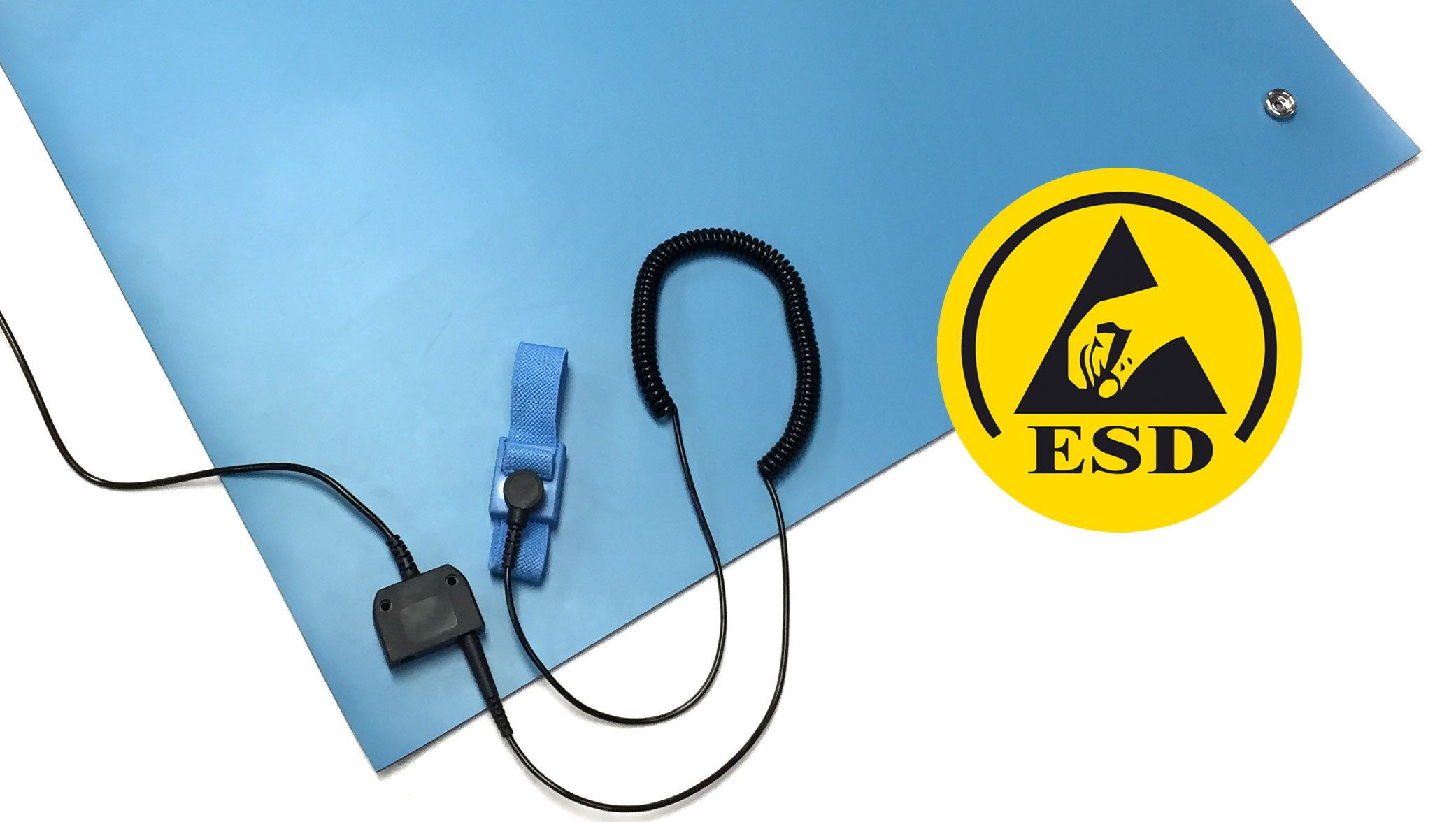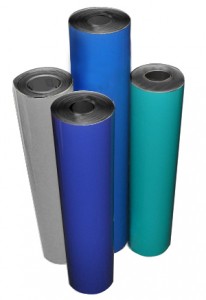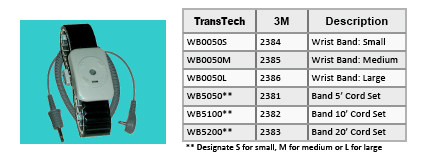Esd Control in Electronic Assembly Slide Show
August 1, 2011
June 22, 2011
Transforming Technologies is proud to announce the addition of the WB5407 to our line of ESD wrist straps. Press Release.
The WB5407 Disposable Wrist Strap offers a safe, effective and economical means for providing static protection to end users of electronic devices. The WB5407 is designed for inclusion with shipments of computer upgrades, network systems and other devices to provide protection at the customer’s site.
Constructed from a durable non-woven fabric impregnated with a conductive polymer, the WB5407 provides 360 degree skin contact to assure proper skin to band resistance. A convenient loop at one end of the device facilitates the formation of a wrist strap.
The other end of the device uses a conductive adhesive on a copper foil for easy contact to any electrical ground. A current limiting resistance is built into the fabric for operator safety.The WB5407 Disposable Wrist Straps are individually packaged in a sealed plastic bag printed with user instructions.
For price and availability on the WB5407 or for information on any products in Transforming Technologies full line of ESD products, please call 419-841-9552 or email eric@transforming-technologies.com.
June 16, 2011
 An ESD mat is a very important part of an ESD protected area.  ESD mats are designed to eliminate static on its surface and of objects placed upon it.  It does this by having a conductive material embedded within the mat that collects the static and sends it to ground
An ESD mat is a very important part of an ESD protected area.  ESD mats are designed to eliminate static on its surface and of objects placed upon it.  It does this by having a conductive material embedded within the mat that collects the static and sends it to ground  (earth). This is usually accomplished by connecting the mat to ground (typically the center screw of an outlet) with a ground cord. It’s important to discharge at a slow rate, therefore a resistor in the ground cord is recommended.
(earth). This is usually accomplished by connecting the mat to ground (typically the center screw of an outlet) with a ground cord. It’s important to discharge at a slow rate, therefore a resistor in the ground cord is recommended.
A quick search online or in ESD catalogs reveal a myriad of ESD mat options.  What are the main considerations in choosing an ESD mat?
ESD mats are generally found in two categories: Vinyl and Rubber.  ESD Rubber mats are the most widely used mat material because they have a high resistance to heat and most chemicals. ESD Vinyl mats are also used for tabletop or work surface applications. They are easy to cut, and some varieties provide cushion. The type of material is a primary concern if you will be using a constant monitor because some materials are incompatible with certain constant monitors.
ESD mats are available in single, two and three layer material. Mats are made of a single homogenous conductive layer material, two layers of static dissipative rubber material or vinyl with a conductive material sandwiched between two layers. Thickness, texture, and cushioning of the mat are also concerns depending on the application. Regardless of composition, all mats should meet or exceed the requirements of ANSI ESD-S20.20.
ESD matting typically comes in 50′ or 60′ rolls in four standard widths: 24″; 30″; 36″ and 48″. The material is easy to cut and has a long shelf life so if you have more than one area to cover or expansion is a possibility,  purchase a full roll and cut pieces as needed. Many suppliers also provide ready-to-use pre-cut mats with grounding hardware already installed. These mats can be more expensive, but it can also be a great time saver.
purchase a full roll and cut pieces as needed. Many suppliers also provide ready-to-use pre-cut mats with grounding hardware already installed. These mats can be more expensive, but it can also be a great time saver.
All static control mats are not created equally. The ESD mat’s long-term electrical properties are tantamount to successfully controlling an ESD event. The terms insulative, conductive, and dissipative are all terms that subdivide ESD materials based on their individual surface resistance. Surface resistance is a measurement of how easily an electric charge can travel across a medium (Visit here to learn How To Test ESD Mats). Conductive materials have a surface resistance of less than 1 x 10 5 ohms/square. Dissipative items have a surface resistance of more than 1 x 10 5 ohms/square but less than 1 x10 11 ohms/square. An insulative material is one that has a surface resistance of greater than 1 x 10 12 ohms/square. Based upon your application, ESD mats should be in either the dissipative or conductive range. Something insulative is not considered ESD safe.
When choosing an ESD mat, first use your specific application to narrow your choices, such as mat material and electrical properties. Carefully plan and budget your workstation so that you can choose to purchase a full roll or a pre-cut mat. Finally, do not let cost dictate your decision – saving a few dollars on low-quality matting could have very costly consequences via catastrophic damage, latent failures and customer complaints.
For help choosing your ESD mat, please call Transforming Technologies at 419-841-9552 or email info@transforming-technologies.com
June 6, 2011
Transforming Technologies is proud to announce the addition of the HG1360NM-2 to our line of ESD heel grounders. 
Non-marking heel grounders are valuable because they help keep your controlled environment clean. The HG1360NM-2 is constructed from a non-marking and highly dissipative three layer rubber. The reversible 1.5†wide rubber cup, secures both at the back and underneath the heel. Its 7.5†length rubber provides enough cup volume to fit comfortably on those with larger shoe sizes. The 7†stretch hook and loop enclosure ensures a comfort fit. For more information, download HG1360NM-2 Data Sheet.
Features
For price and availability on the HG1360NM-2 or for information on any products in Transforming Technologies full line of ESD products, please call 419-841-9552 or email eric@transforming-technologies.com.
May 10, 2011

CS1010 Push and Clinch Snaps From Transforming Technologies
Grounding snaps are used to connect a ground cord to a work surface static safe mat or a ESD floor mat. An antistatic floor mat or ground mat is one of a number of antistatic devices designed to help eliminate static electricity. It does this by having a conductive material embedded within the mat that collects the static. The mat would need to be grounded (earthed). This is usually accomplished by plugging into the grounded line in an electrical outlet.Pronged Push and Clinch snaps are ideal for multi-layered surfaces and come as a male stud or female socket and are offered in 10 mm (3/8â€Â) size.
Download How to Install Ground Snaps.
Snap Installation:
1. Place ESD matting on workstation. Locate the safest grounding point (outlet).
2. Choose which side of the mat has the closest or most convenient access to the grounding point.
3. Locate an area 1 –2 inches in from each corner of the mat on the side that was determined above.
4. Press snap downward until prongs puncture matting and are fully visible on the underside of the mat.
5. Bend the prongs of the snaps until flush against the underside of the mat.
6. Add additional snaps -for a total of at least two- every 10 feet or the length the mat allows.

Ground Snap Install Instructions
April 7, 2011
ESD Protection in the Field
Static damage is a constant threat anywhere micro-electronic components are used, but these components are at highest risk during servicing. The Transforming Technologies’ FSM2424 Field Service Kit is designed to quickly and reliably remove static charge on the service technician and provide a safe static-free surface to lay parts. The kit includes a 24†x 24†rugged mat with two 8†x 12†pockets for storing tools, an adjustable wrist band, coil cord and 15’ ground cord.
The FSM2424 Field Service Kits eliminates static charge through the principle of grounding. Both the mat and the operator’s wrist band connect to the specialized ground cord which when properly connected to ground, provides a safe path for static charges to drain to ground.

Field Service Procedure
1. Upon arrival at the service call site, unpack the field service kit in a convenient area near the equipment to be serviced.
2. Remove any accessories from the pockets and attach the ground cord to the mat via one of the two snaps found in the corner of the mat.
3. Connect the opposite end of the cord to a reliable ground. Common ground locations are water pipes, unpainted equipment frames, and building frames.
4. Slip on the wrist band and adjust the size to fit comfortably around the wrist but tight enough to make contact with the skin at all times. Snap the coil cord to the wrist band.
5. Insert the banana plug of the coil cord into the jack of the ground cord. This connects the wrist band to the same common ground as the work surface.
6. It is now safe to remove and handle static-sensitive components.
Field Service Care
The FSM2424 Field Service Kits can be cleaned with ESD-safe mat and surface cleaner or with a mild detergent and water as needed. Once clean, allow the material to air dry, removing any excess water/moisture with an absorbent cloth. DO NOT use heat of any kind to dry mat. Though inherently flame resistant, the field service products will burn with enough exposure to open flame or other heat sources of sufficient temperature. DO NOT use a clothes dryer, as the excess heat may cause the PVC material to retain the shape it held in the dryer. Most strong solvents are not recommended. AVOID: Halogens, concentrated Oxidizing Agents, Ethers, ketones, and Low-Molecular Weight Solvents derived from the Ether and ketones fami-lies. They include (but are not limited to) TetraHydroFuran (THF), Methyl Ethyl ketone (MEK), Methyl Isobutyl Ketone (MIBK) and Acetone. These chemicals will mar and/or destroy the sur-face of the PVC product (the Ketones), react with it (Oxidizing Agents), or actually dissolve it (THF and other Ethers). Wrist strap can be hand or machined washed.
For information on resistance monitoring, dual conductor grounding products or any general questions, please contact Transforming Technologies at 419-841-9552 or email at info@transforming-technologies.com.
April 4, 2011
Resistance Monitoring
Resistance based monitoring is the most complete wrist strap monitoring system available. Workstations using resistance monitors are almost never at risk. Basic systems use impedance technology and single wire wrist straps which can be easily fooled. If a wrist strap is worn incorrectly, the monitor can still register a “pass†condition or if the wire of the wrist strap is severed the workstation could be put at risk for ESD damage. Dual conductor wrist bands offer fail safe protection because the monitor will alarm if the operator looses contact with one ground wire. It is very rare to loose both ground wires at the same time, so the workstation is still protected even during a alarm condition. The CM2800 series from Transforming Technologies is a high quality resistance monitor and provides continuous monitoring of two operators, two mats, or two grounded workstation tools.

CM2800 Dual Wire Constant Monitor
A New Cost Effective Source
For many years, resistance monitoring and dual conductor products were limited to mainly 3M. But Transforming Technologies now offers a value alternative for these premium 3M* dual conductor products. We incorporate the best design elements of expired patent # 5,018,044 with our own experience making premium quality ESD products to produce the WB5000, WB7000 to be used with the resistance monitor CM2800 series. Transforming Technologies and 3M’s dual conductor products are functionally equivalent*. The wrist bands, coil cords and resistance monitors can be used together in any combination!

Both 3M and Transforming Technologies’ Speidel metal band feature two 180 de-gree conductive paths around the wrist, providing maximum skin contact. The expandable band is constructed with two stainless steel back plates and is available in small, medium and large sizes.

Transforming Technologies and 3M’s fabric wrist strap features a band made of a silver plated, monofilament, continuous thread woven together with elastic nylon to maintain full conductivity, comfort and reliability, while providing rapid and con-tinuous drain of static charge.
Coil Cords
Used in conjunction with dual conductor constant workstation monitors, Transforming Technologies’ CC3000 series dual conductor coil cords provide unmatched reliability and value. A double insulated jacket provides incredible durability and a wide diameter straight plug makes it easy to insert and remove the cord from a remote input jack. The coil cord come standard in 5’, 10’ or 12’ lengths and are functionally equivalent to the 3M coil cords.
 *Compatibility with particular resistance monitors should be verified.
*Compatibility with particular resistance monitors should be verified.For information on resistance monitoring, dual conductor grounding products or any general questions, please contact Transforming Technologies at 419-841-9552 or email at info@transforming-technologies.com.
March 21, 2011
Constant Monitors are excellent tools for static control and should be considered for any grounded workstation. ESD Constant monitors reduce production costs by eliminating the time spent on testing wrist straps before each shift. Further savings may be realized by reduced ESD damage from malfunctioning wrist straps. But a quick web search results in a dizzying amount of options. The following article outlines the important considerations when choosing an ESD Constant Monitor.  For more information, please read “Survey of Constant (Continuous) Monitors for Wrist Straps” in the ANSI/ESD S20.20.
Type of Constant Monitors:
There are several types of constant monitors available. Understanding the different technologies used for constant monitoring will make your decision easier. For the purpose of this article, we will be reviewing the two most common types: Impedance and Resistance Monitors.
Impedance (or single wire) constant monitors
Impedance monitors use a very low AC voltage to detect a person though a single wrist strap. When a person is attached and the wrist strap is functioning, the monitor is in an unalarmed state. The impedance monitor uses the phase difference between current and voltage to detect changes in impedance of the cord, band and person. A detection circuit is used to reduce false alarms and eliminate adjustments. These types of monitors list anywhere from $30-$100 and any standard wristband and coil cord can be used. The CM400 series from Transforming Technologies are single wire impedance monitors.
Resistance (or Dual Wire) constant monitors
This type of monitor is used with a two wire (dual conductor) wrist strap. When a person is wearing a wrist strap, the monitor observes the resistance of the ground loop, consisting of a wire, a person, a wrist-band, and a second wire. If any part of the loop should open (become disconnected or have out of limit resistance), the circuit will go into the alarm state. An important feature of the dual wire wrist strap is that even if one conductor is severed, the operator has reliable path-to-ground with other wire. These types of monitors range from $80-$200 and must use dual wire wrist straps. The CM2800 series from Transforming Technologies area full line a Resistance Monitors and can be used with most commercially available dual wire wrist straps.
Monitoring Features:
Constant monitors can be very simple, or can be loaded with bells and whistles depending on the application. The following are some common features:
Work surface Monitoring: An option available with some constant monitors is the ability to monitor work surface ground connections.
Tool Monitoring: Constant monitors may also monitor grounded equipment in a manner similar to work surfaces.
Data logging: Some monitoring systems have data recording capabilities.
Adjustable Alarms: Some monitors allow users to set the alarm parameters in order to satisfy higher ESD standards.
Alarm Accessories: Display modules, external relays and sirens are available for specific applications.
Conclusion:
Constant monitors are reliable, money saving devices used ensure elements of a workstation are grounded. Single wire monitors, such as the CM400 series from Transforming Technologies use single wire wrist straps and impedance technology to ensure grounding. The CM400 is the most cost effective and monitors one wrist strap. The CM410 monitors one wrist strap and the work surface. The CM420 is the fully loaded model that monitors two wrist straps and the work surface. The CM2800 dual wire constant monitor from Transforming Technologies is the top of the line and monitors two wrist straps, two work surfaces, two grounded tools and has user programmable alarm parameters. The entry level CM2815 monitor uses the same great design of CM2800 and monitors two wrist straps, and two work surfaces. Use the following graph to help choose your constant monitor:
March 14, 2011
Introduction
Have you ever wondered what it means when a heel grounder described as having a “1 meg resistor”? or a 2 meg resistor? The size of a current limiting resistor is often included in the description of personal grounding products, but what does it mean and how concerned should I be with the size of the resistor when I am buying heel grounders? Today we will answer these questions but first some background:
What is a Resistor?
A resistor is a component of an electrical circuit that resists the flow of electrical current. A resistor has two terminals across which electricity must pass, and is designed to drop the voltage of the current as it flows from one terminal to the next. A resistor is primarily used to create and maintain a known safe current . Most grounding products have a current limiting resistor and it is most commonly one megohm, rated at least 1/4 watt with a working voltage rating of 250 volts. This ensures that the flowing current will be within safe levels.
Heel Grounders and ESD Protection?
Heel grounders discharge static from a person to ground by connecting the person to a grounded walking surface. A heel grounder is made from a conductive material and is worn on each shoe. A conductive ribbon placed inside the wearer’s shoe or sock makes electrical contact with the skin through perspiration. The ribbon is joined to a resistor which limits current should accidental exposure to electricity that may occur. The other end of the resistor is joined to a conductive sole. This sole contacts a grounded ESD floor mat or ESD flooring system. Heel grounders should be worn on both feet to maintain ground contact while walking. UL and OSHA recommends a minimum of 1 megohm resistance to ground (RTG) in order to limit current for safety purposes.
Types of Heel Grounders?
Heel Grounders come in a variety of styles:
Resistors and Heel Grounders
Heel grounders come with either a 1 megohm or 2 megohm resistor. When one foot is on the ground, a 1 megohm heel grounder gives you an RTG of 1 megohm and a 2 megohm heel grounders results in 2 megohm RTG. But when both feet are on the ground, the sum of the resistors yield a RTG of 1/2 that measurement.
For example:
This can be sometimes confusing. So we made a diagram to illustrate:
Conclusion
Heel grounders are an effective and popular way to ground mobile personnel in ESD areas. Heel grounders use built in resistors to limit any potential current that flows through the device to ensure operator safety. The size of the resistor that you use depends on the standards of the specific operation, but by wearing two heel grounders with a 2 megohm resistor you are complying with UL and OSHA at all times.
To learn more about ESD heel grounders and Resistors, visit Transforming Technologies.com